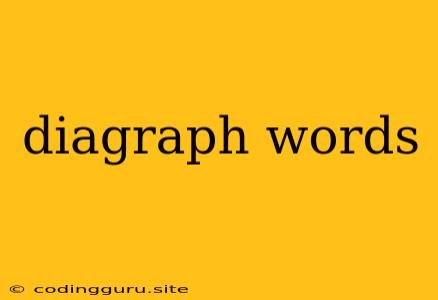What are Diagraph Words?
In the realm of language, words are made up of letters that combine to form sounds. Sometimes, two letters work together to create a single sound, like "sh" in "ship" or "th" in "think." These pairings are called digraphs. Diagraph words, then, are words that contain these letter combinations that represent a single sound.
Understanding diagraph words is crucial for young learners who are developing their reading and spelling skills. Let's dive deeper into the world of diagraphs and explore how they contribute to the richness and complexity of our language.
Why are Diagraph Words Important?
Diagraphs are essential for learning to read and write because:
- They represent sounds that aren't represented by single letters: Many sounds in the English language aren't represented by a single letter. Diagraphs provide a way to represent these complex sounds.
- They introduce phonetic awareness: Learning to recognize and understand diagraphs helps children develop phonetic awareness, which is the ability to identify the sounds that make up words. This awareness is critical for both reading and spelling.
- They enhance decoding skills: By recognizing diagraphs, children can decode words more quickly and accurately. They can break down words into their component sounds and blend those sounds together to read the word.
- They improve spelling accuracy: Understanding diagraphs also helps children to spell words more accurately. They can learn the common letter combinations that represent specific sounds and use this knowledge to spell words correctly.
Common Diagraphs in English
There are many different diagraphs in the English language, but some of the most common include:
- sh as in "ship," "fish," and "crash"
- ch as in "chair," "much," and "catch"
- th as in "thin," "them," and "bath"
- wh as in "what," "when," and "where"
- ph as in "phone," "graph," and "photo"
- ck as in "back," "sick," and "luck"
- ng as in "sing," "long," and "king"
- ai as in "rain," "train," and "wait"
- ee as in "see," "tree," and "feet"
- oa as in "boat," "coat," and "road"
- ou as in "house," "mouse," and "cloud"
How to Teach Diagraph Words
Here are some tips for teaching diagraph words to young learners:
- Start with simple diagraphs: Begin with common diagraphs, like "sh," "ch," and "th."
- Use visuals: Use flashcards, posters, or even simple drawings to help children visualize the diagraphs and their corresponding sounds.
- Practice with games and activities: Make learning fun with games and activities that focus on diagraph words, such as word searches, matching games, and memory games.
- Read aloud books that feature diagraphs: Choose books that include words with diagraphs, and point out the diagraphs as you read.
- Encourage independent practice: Give children opportunities to practice identifying and using diagraphs on their own, such as through writing activities or word games.
Examples of Diagraph Words
Here are some examples of diagraph words that you can use to teach young learners:
- sh words: sheep, ship, shell, shark, shoe
- ch words: chair, cheese, chicken, child, chin
- th words: think, thumb, thank, this, that
- wh words: where, what, when, why, wheel
- ph words: phone, photo, graph, elephant, alphabet
- ck words: back, kick, sock, rock, clock
- ng words: sing, ring, long, king, bring
Conclusion
Diagraph words are an essential part of learning to read and write English. By understanding these letter combinations and the sounds they represent, children can develop strong foundational reading and spelling skills. Through engaging activities and consistent practice, young learners can master diagraphs and unlock the world of words!
